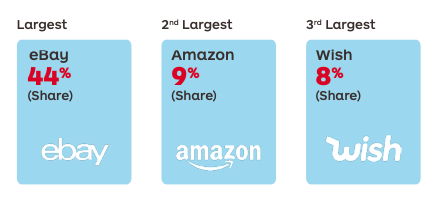Last year saw tremendous growth in Australian ecommerce and is expected to maintain an upward trend in the next few years. Are retailers still on track with their online marketing strategy for 2020?
Insight: With the continued rise of new technology, today’s online shoppers expect greater convenience and better choices.
Data: Ecommerce in Australia is growing rapidly, with online spend reaching 10% of total retail sales in 2018, taking its share to two percentage points higher than the previous year. (Australia Post)
What’s the step change: Learn the ecommerce trends dictating how online shopping is shaping up for consumers.
According to the 2019 eCommerce Industry Report, the number of online purchases in Australia grew by more than 13% year on year with the national average growth over 20%. Online shoppers are exploring new ways to get what they need fast and are not afraid to try new channels and marketplaces to buy online.
Mobile shopping and seamless user experiences across multiple channels remain central to ecommerce businesses today. But the competition is steadily increasing, and smart shoppers have higher expectations with their online shopping experience — looking for more personalisation, faster fulfilment, quicker support turnaround times, and a reliable platform that can offer them the security they need to go about their shopping sprees in peace.
With higher shopper expectations to cater to, here’s a look at ecommerce trends that will dominate this year.
Personalised and Seamless Shopping Experience
Today’s online consumers expect a personalised shopping experience and look to ecommerce brands that can provide them with product offerings relevant to them and their needs.
In 2020 and beyond, more ecommerce brands are expected to make use of big data to build better relationships with their customers. This means in 2020 and into the future, retailers need to focus on how they can add more personalised features into their websites, tailoring content according to customer behaviours, and improving product recommendations if they want to be top of mind.
Voice Search, Virtual Assistants, and AI-Enabled Chatbots
Continued developments in technology have transformed today’s modern shoppers. They now opt for online marketplaces that can provide them with a more personalised shopping experience. In 2020 and into the future, virtual shopping assistants and AI-enabled chatbots will be more commonplace.
The eCommerce Industry Report notes that almost 1.35 million Australian shoppers own a smart speaker as of 2019. The growing use of smart speakers such as Alexa and Google Home and virtual assistants like Siri means Australian retailers need to ensure their content is optimised for voice by 2020 to boost sales and promote a more direct-to-consumer experience.
With 30% of online searches done without a screen, ecommerce businesses and retailers need to improve how they tag their products to maximise their sales.
On the other hand, AI-enabled chatbots that can provide tailored product recommendations satisfy the growing consumer need for 24/7 support and a more personalised shopping experience. Ecommerce retailers should explore how they can integrate chatbots and virtual assistants into their conversion strategy.
Faster Fulfilment and Flexible Online Payment Options
With today’s online consumers embracing the use of new technology, their shopping habits are also continually changing. Most online shoppers today not only expect a seamless online shopping experience, but they also prefer faster product checkouts and buying transactions in shorter amounts of time as they continue to shop on the go and across multiple devices.
To accommodate this need, retailers will need to adapt and offer faster payment options and channels that will give consumers the flexibility they need to complete online transactions conveniently.
The Australian Post reports that 68% of consumers in Australia, the US, and the UK will cater to biometric payments in the next few years. Not only does this provide better security and safeguards customers from fraud, this can also improve the checkout processing time dramatically.
A Preference for Marketplaces and Online Platforms
Around 73% of Australian households shopped online in 2018. With the continued increase in online shopping, the Australian Post eCommerce report also predicts that ecommerce penetration will increase to 12% of retail spend within the next three years.
eBay continues to dominate as Australia’s most popular ecommerce platform with a 44% share in purchases followed by Amazon with 9% and Wish with 8%.

To stay relevant to their target audience, retailers will need to think about how they can improve their online marketing efforts or, if they haven’t done so already, find a way to build their presence online and fast.
Big Data and Customer Analytics
Having access to so much data today, retailers have better customer insights that can help with personalising the consumer’s shopping experience. Point-of-sale data can provide a look into customer preferences and demographics and should entice retailers to go beyond using this data for reporting.
POS data analysis software like Vend and Reckon Cloud POS provide point-of-sale, inventory, and retail analytics that promote better accuracy in terms of forecasting and analytics.
Retailers can make use of these predictive analytics software to drive their online marketing campaigns and promote better product strategies.
This will also challenge retailers to be more careful of customer data and privacy, which brings us to our next point.
A Need for Consumer Trust and Better Privacy
With the GDPR in effect, retailers are called to not only focus on giving the customers what they need, they are entrusted with the responsibility to protect consumer data to the utmost not only today but into the future.
With mobile payment options becoming more commonplace, mobile devices will be more targeted, thus leading to a call for more stringent cybersecurity measures from retailers and other ecommerce businesses.
Ecommerce brands will need to think about how they can enable better customer protection in terms of cookie blocking and tracking. Apple has Intelligent Tracking Prevention software, which has proven to be effective for preventing ad tracking, but this could potentially impact analytics and data mining as well.
With data accuracy being impacted, ecommerce brands will also need to consider how they can stop relying on cookies for tracking and marketing.
In 2020, retailers will need to balance having access to more data with the call for building consumer trust.
Tying It Together
With the speed of adoption accelerating throughout the industry for emerging ecommerce trends and new technology, businesses and retailers must decide what strategy will work best for them and start getting their resources together.
With many retailers looking for ways to stand out from their competitors, those who are most in tune to their customer’s changing preferences and needs and are able to deliver fast will win.
For 2020 and beyond, personalisation, faster fulfilment, and better security for online transactions will continue to dominate customer expectations and should remain central to every online strategy for ecommerce brands.
















